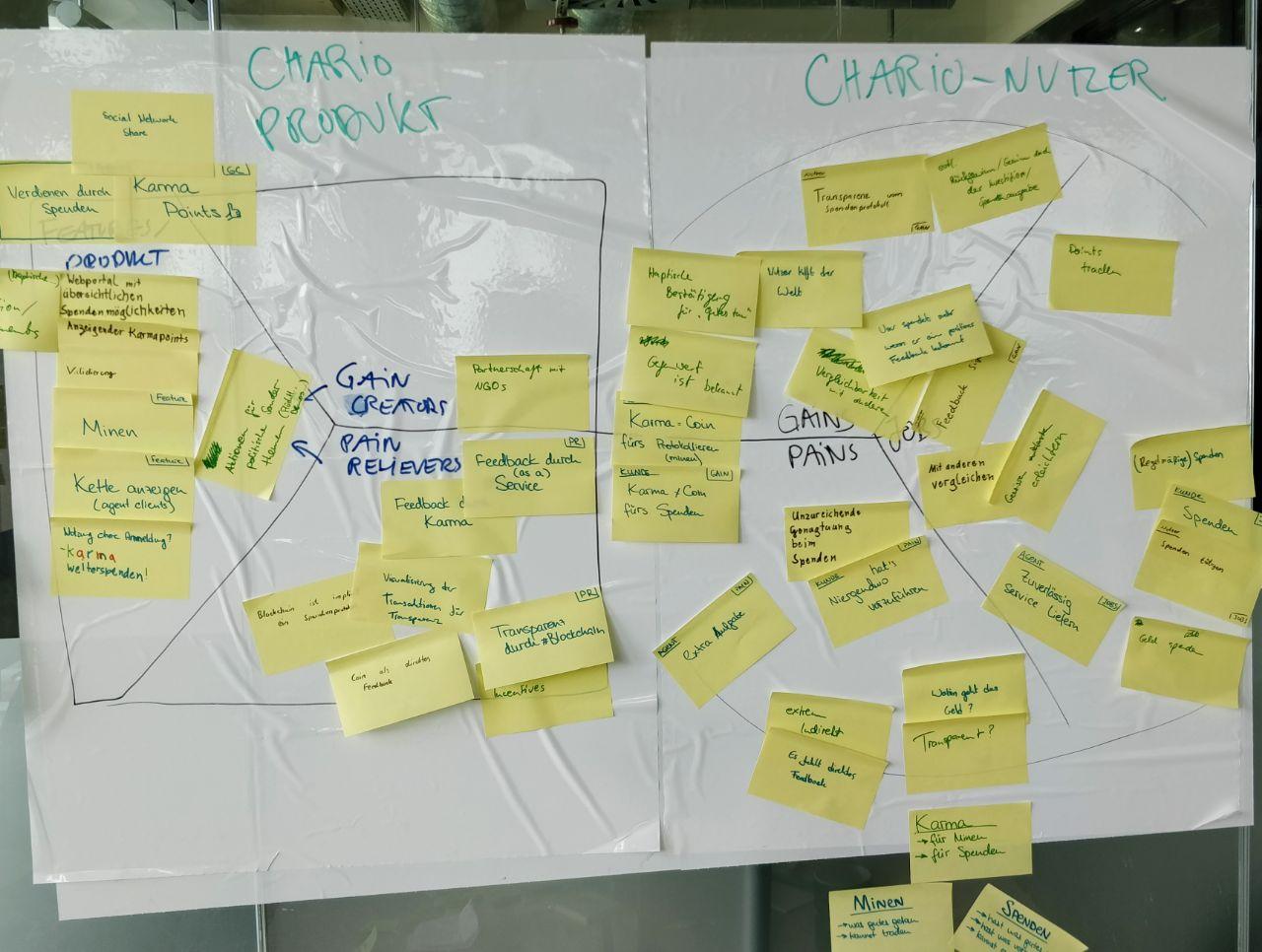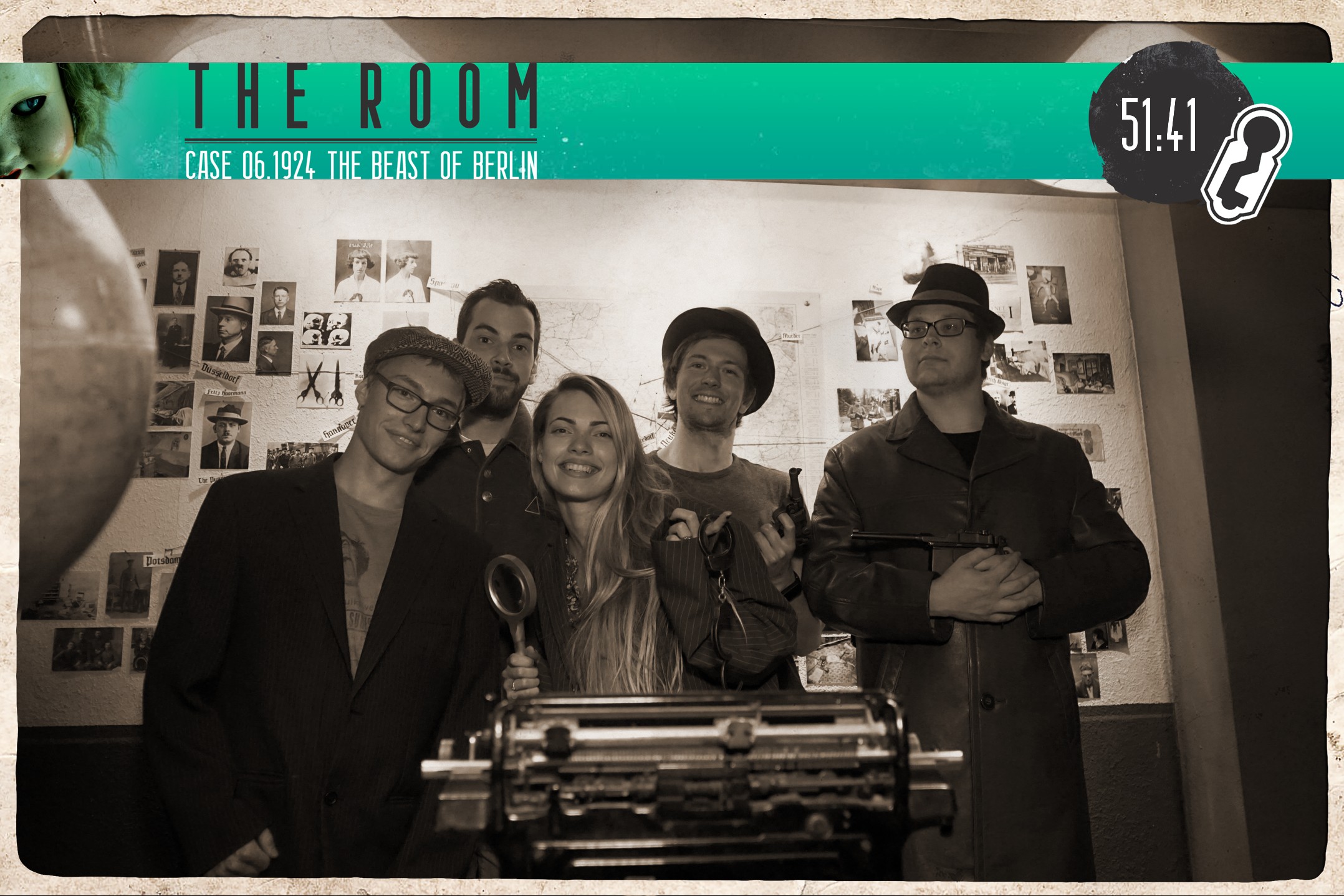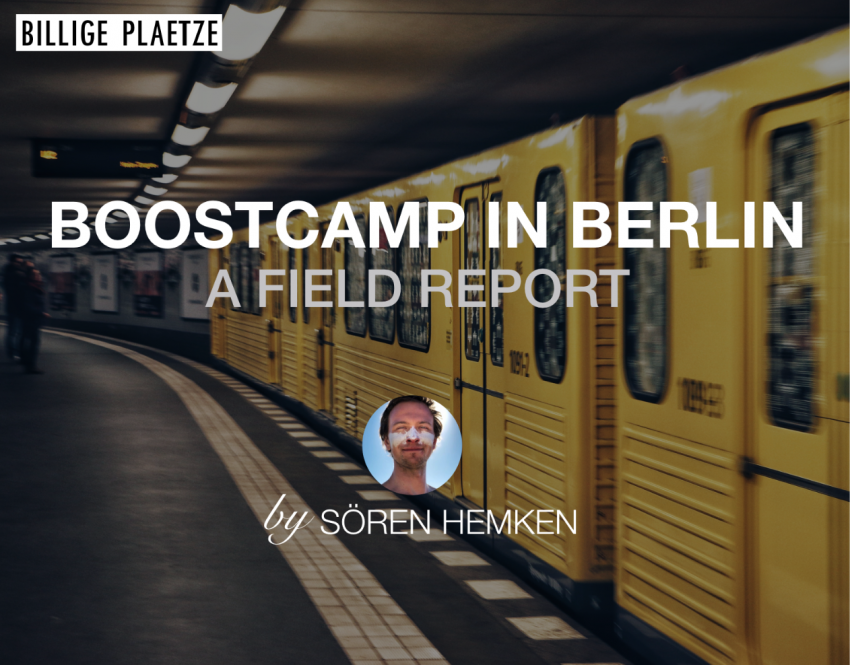Every season we are attending to a hackathon. This spring we went to one of the biggest in Germany, so they say, the Open Codes Hackathon in Karlsruhe. As one out of ~50 Teams we could choose one competition-category out of three:
* Art & Technology, powered by ZKM
* IT Brings People Together, powered by CAS Software AG
* Connect the Worlds, powered by EXXETA AG
So as we sat down to brainstorm about possible projects we came up with one that solves one main issue in the charity-ecosystem, connecting the concept of blockchain with charity – two worlds connected – we called it “Chario” and registered for EXXETAs challenge.
We developed an app for middlemen (Agents) and a web page for benefactors, both connected through a backend that facilitates the data between them. With our system, we enable benefactors to choose where exactly to donate to, then chose one out of several possible donation-types (material or money) to finally trace the donation throughout the process, till it finally reaches the beneficiary (proven by a photograph). After 24hours of creative teamwork, coding, struggling and getting-shit-done, a huge amount of coffee and a 15 minutes pitch to the EXXETA team we were done, and yet we somehow managed to hold on till the very end. Don’t underestimate the pressure you’re feeling and the effect of sleeplessness on your nerves when you didn’t sleep for around 36 hours, facing a pitch in front of 200 people. Somehow, we gathered all our inner forces and simply just performed. The rest still seems blurry somehow: We didn’t expect to win anything, so we were surprised, yet very very happy and thankful as Matt was standing on the stage, shouting out our name, saying we won the Category-Price “Connect the Worlds”:
Not knowing what huge effect this prize will have on our team experience and future plans… in this blogpost, I will try to give you a small insight of what we learned. Be aware though, this is just one brick on the wall. There were side-stories and a lot going on between us, the other participants, the amazing EXXETA team, Berlin, clubbing, cocktails, accommodation issues, and so much more… all in all, this was a trip we’ll hopefully never forget.
What happened so far?
Obviously, our EXXETA-Go-To-Guy Matt couldn’t wait to get the workshop started, so he directly added Danny and me on LinkedIn. Quickly we exchanged email addresses and phone numbers. We agreed to make a call with all Billige Plätze on Skype which turned out to be casual and welcoming, our excitement grew. In the aftermath I can only assume how much energy went into planning and organizing the workshop, in the background Matt and his colleagues must have started right away – impressive – what an eager team! Soon they sent us successively more and more info about what’s about to come. The last notice was, that we should re-prepare our pitch from the hackathon. Like most of the projects born at hackathons, there has no further work been done for Chario, even though it was, like all the times, also a project we’d like to keep working on… Since only Dominik, Leon, Danny and I attended the hackathon and won the price, it was more than just nice that they also invited the rest of our real Team “Billige Plätze”. Hence, all of us are on the way to Berlin right now, looking forward to the next days and experiences.
And as we are on our way to Berlin now, I’m getting started with this field report, my diary of our experience of the workshop with EXXETA…

Who is EXXETA?
With more than 750 employees EXXETA AG is a big international player in Technology Consulting for the Energy-, Automotive- and Finance sectors. They have several offices all around Europe, most of them in Germany. The team that invited us is known for innovative and unconventional, yet successful methods and measures to get things done. They are situated in the WeWork Coworking office in Berlin – next to the Sony Center. During the workshop, we got to know a few colleagues of Matt and were amazed by the casual, young spirited, yet professional style.
Day 1
The Factory
We were a group of 12 plus the EXXETA coaches. First stop was the Factory. The Factory is an amazing Coworking space for innovators and startups that grow a community by carefully choosing who joins the network. Not only are the offices well designed and furnished, but also it scores with features like a ball pool, foosball, huge kitchen with coffee for free, space for networking and getting to know like-minded people. There we met the IoT and Blockchain company builder Next Big Thing.
Meet&Greets
Next Big Thing – What does a Company Builder do?
Next Big Thing (NBT) specializes in IoT and Blockchain startups to give them a quick and smooth start. This is especially helpful when it comes to startups with hardware-based innovations. NBT supports a startup not only with access to a big network of startups and investors, but also pays you a fair monthly salary and helps you to deal with topics like IT-security, technical certification and standards, legal regulations, bureaucracy, HR administration, accounting, marketing, pitch-coaching, recruiting, office infrastructure, workshops and much more. Also, they have a highly-specialized senior developer team, supporting you with additional operative workforce to get your product onto the market. They developed a program called “Venture Design”, where NBT leads you through all the necessary steps for building your own company. My key learning of this visit was, that all of their startups ended up with another product as they actually began with. Therefore, they rather decide on a team or person, than the idea that got pitched in the first place.
Entrepreneur Alexander Barge
Next station was lunch, where we met Alexander Barge. Alex is a highly experienced Entrepreneur and deeply integrated into the Berlin startup scene. There we had the opportunity to place our questions in a personal atmosphere and get first-hand advice. So after we got introduced to the complexity of founding, Alex managed to motivate and encourage to start something new, thanks to his enthusiasm and up-beat. As a CTO and Co-Founder himself, he made it clear, that you can “just start”… of course it is a lot of work, and you will never lose that bad conscience of “actually I should be doing something” whenever you’re not working, and eventually you’ll fail at the beginning – but there will be progress, excitement, a lot to learn and eventually a chance for success. It seemed a bit like what I told you in my previous blog post (“How to start and learn coding”) – all you need to do is get your a$s up, start and stick with it as much as possible. So next to the delicious food we dined that fantastic enthusiasm.
Blockchain Lab at GIZ
Since the Chario-Concept was driven by a non-commercial idea and we mentioned the idea should be realized with blockchain-technology, the next stop was the Blockchain Lab at the GIZ (German Corporation for International Cooperation GmbH). Franz von Weizsäcker and his team are trying to find sustainable use-cases for blockchain technology. With the technology of Blockchain, it generally feels a bit like there is a solution without knowing the problem it can solve yet – so it needs specialists like Franz(s team) to find out where to place this technology without risking an alienating effect.
We asked what they think about our idea and if it seems realizable. The answer made clear, that in the charity-ecosystem there is a big resistance towards change, especially when it means that i.e. middlemen might earn less than before – yet, the use-case of connecting blockchain-powered traceability with donations is very promising and powerful.
After a short break and retrospective come-together, Matt introduced the first canvas to get a business model sharpened.
Working with the Value Proposition Canvas
We started with a canvas which is supposed to help to focus on the user’s needs and then find possible solutions. Here you can find a nice and simple explanation of the canvas:
How we did it: Field by field, we were timeboxing silent brainstorming-phases of around 3-5 minutes, where everyone wrote the ideas on Post-Its. Followed by putting those on the canvas, one by one. Each session continued with a short discussion about discrepancies and different opinions until we go to the next field.
We were working through the canvas in this order: Jobs => Pains => Gains => Pain Relievers => Gain Creators => Forming the products and services. The moment you are done with the canvas it is useful to go over it again, cluster it by topics, and at the end prioritize the features to decide whether it is an essential part of the Minimal Viable Product (short MVP) or not. Here is our result – a bit messy, and yet we all like it:

Our First Little Pivot
Within this process, we figured out that we got to change something about the product-idea since there are two main issues
- Issue one – Transparency: Why would non-governmental organizations (short NGO) and their middlemen cooperate with us to make the effort and implement transparency features in their processes?
- Issue two – Proof of good work: How can we know who needs the donations?
We learned that a service/ system or product that solves all the issues would be too big as a start, so we wanted to pin down possible features for an MVP.
And even though we found possible solutions for those two issues, we realized that none of us are somehow eager to dig deeper into any of them. Motivation is key! So based on our first result we decided on developing a system that motivates future benefactors and helps NGOs to raise more money. The idea went a bit into the direction of something like payback for NGOs, but better… of course 🙂
After an exciting first workshop day, the team ordered pizza which got accompanied by insights of EXXETA from the development team leader Sébastien Jelsch. He was stating that, if you don’t want the insecurity of a startup, yet work alike, in a team of people who want to make a change, you may check out what’s in the job listings on their page 😉
Day 2
The second day was all about getting our first business model-draft done. After a short tour through the amazing Coworking office WeWork, we got to work, more focused than ever, quickly filling up the Value Proposition Canvas and sharpening the concept.

Business Model Canvas
The Business Model Canvas is a lean method to nail your business model down to its core. Find out more about the canvas here:
We easily went through this canvas. The product and the organization around it was clear to us, so there was hardly any reason for discussion. The Value Proposition Canvas was a perfect preparation for this one. Here is our result:

The next step would be to go over it and distill the core out of our brainstormed-content.
What is the LVLX Summercamp?
During our lunch break, Matts boss came around, wanted to know how we like the workshop and told us about the LVLX Summercamp. It is a paid six-weeks-program for (mostly) students who want to focus on their idea or product and get supported by EXXETA and their “high-society”-partners. If it wouldn’t be so entirely impossible for us to take part, we had not hesitated one millisecond. I’ll be following the outcome of that workshop, knowingly that all the potential they gather and own, there got to be some pretty impressive results.
One Metric That Matters (OMTM)
To get back to work Christian Grimm from EXXETA gave us an important side note: Focus on the right thing is essential for the success of all the phases a startup goes through. And the argumentation is simple: You don’t have a lot of resources and time, so the only way you can get more of each is by using the bit you have for the right things. Defining one metric / KPI can drastically help to consequently align the work and focus of a team. In the beginning, it’s the key to look for “softer” or money-unrelated KPIs, like positive/ negative-feedback-quota or percentage of MVP-features, developed, rather than sales or ARPU. If you are interested in reading more about this, I can really recommend this blog: Lean Analytics Book.
The Timeline
With this at hand we managed to finish our first self-developed Business Model Canvas, and so we moved on to the last part of the conceptual day: the timeline. Nearly as easy as it sounds, you define three time-intervals and decide for each of those phases your goal, invest, team size, OMTM, hypothesis, important tasks, open questions and possible obstacles.

Intrapreneurship
The following talk of Philipp Stork was about a question that big companies started asking: “Why can’t we be as quick as a startup?” The phrase “Intrapreneurship” indicates that those companies should develop an entrepreneurial mindset within its employees and empower them to pursue their demand for creating something new, in the name of the employer. This sounds like a pure win-win situation, you maybe think? Research shows that there are companies that fail to implement a startup character within a motivated team, or sadly still don’t want to see this “unconventional” method as a valid solution. Yet when a company goes that way and really empowers their Intrapreneurs, there is a chance of success.
Entrepreneurship
Since most of the meet&greets, talks and tasks of the workshop were about sharpening our concept for a possible startup, in his keynote, Matt managed to find the right words about what it takes to be an entrepreneur. He broke it down into three main-skills:
1. Think outside the box: Because there will be moments you couldn’t foresee, and you have to react, there will be problems you have to solve creatively and pragmatically, you got to be able to improvise and surprise!
2. Be focused: Just as mentioned before – use your resources effectively. As an entrepreneur you can only set small accents, yet if you place those correctly, you can make a change, because you have the freedom from all the internal politics, bureaucracies, hierarchies and everything else that slows down bigger companies, but a big chunk of motivation, team-feeling, including the responsibility to quickly launch your product with the available resources, and beat incumbents to market.
3. Don’t get discouraged: Especially after the first few days / weeks it comes again: The daily business – just like in a relationship, you will have to make the transition from “having a crush” to “being in love”. On a journey as a founder, you meet a lot of naysayers just as sure as failure will happen. This should never be a reason to think about stopping, but to stand up, learn from mistakes, filter between good and bad advice and have the courage to learn and maybe change a plan quickly.
There is plenty of literature about how to get started with your startup. Here is a Must-Read for anyone who is actually thinking about it: Startup Playbook by Sam Altman.
Afterward, we sat down and enjoyed a wonderful cold beer in the Coworking space WeWork, where we stayed a bit longer, till we finally had to leave, and the evening celebration got started.

The Sum Up
So what do we take away from this two wonderful workshop-days?
First of all, we gathered a lot of insights when it comes to founding, depending on what product you work on. Secondly, we developed an idea that we might pursue in the close future. Thirdly the EXXETA team managed to pack our bags with the right tools to work on further ideas, what we’re going to try out at the next hackathon or other future projects. Last but not least, we got a glimpse of the Berlin startup ecosystem and found a lot of new friends – all of us were purely amazed! We, the team Billige Plätze, had a very fruitful, intense and important time with each other, bringing us together more and more. Who knows what maybe getting started thanks to this experience…

